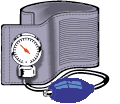|
Hypertension, more commonly known as high blood pressure,
is defined as a systolic reading of 140 mm Hg or higher (the
top number of a blood pressure reading) or a diastolic reading
of 90 mm Hg or higher (the bottom number). Systolic pressure
measures the pressure exerted on the artery walls when the
heart beats; diastolic pressure measures the force on the
arteries between heartbeats.
In
2002, the American Medical Association (AMA) warned that the
majority of the estimated 50 million Americans with hypertension,
also known as high blood pressure, were failing to keep it
"under control." A year later, few people seem to have heeded
that warning, a point emphasized by this study published in
the association's main journal.
 Researchers surveyed a random sampling of the U.S. population
as part of the latest National Health and Nutrition Examination
Survey (NHANES), gathering data on prevalence, awareness,
treatment and control of high blood pressure. Results were
compared with data from the two phases of NHANES III (1988-91
and 1991-94). Researchers surveyed a random sampling of the U.S. population
as part of the latest National Health and Nutrition Examination
Survey (NHANES), gathering data on prevalence, awareness,
treatment and control of high blood pressure. Results were
compared with data from the two phases of NHANES III (1988-91
and 1991-94).
As of 1999-2000, 28.7 percent of NHANES participants suffered
from high blood pressure - a 3.7 percent increase from 1988-91.
Moreover, the condition was controlled in only 31 percent
of patients - albeit a 6.4 percent increase from 1988-91.
Increasing age, female gender and high body mass index (BMI)
were associated with a higher risk of hypertension.
So, now you know all about high blood pressure. The question
is, "What are you going to do about it?" If you're one of
the millions who suffer, talk to your doctor about the best
way to keep it under control.
For more information on hypertension, read some of the latest
research summaries at www.chiroweb.com/find/archives/general/wellness/index.html.
Reference:
Hajjar I, Kotchen TA. Trends in prevalence,
awareness, treatment and control of hypertension in the United
States, 1988-2000. Journal of the American Medical Association,
July 9, 2003:290(2), pp199-206.
|



